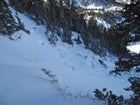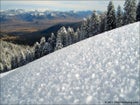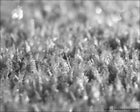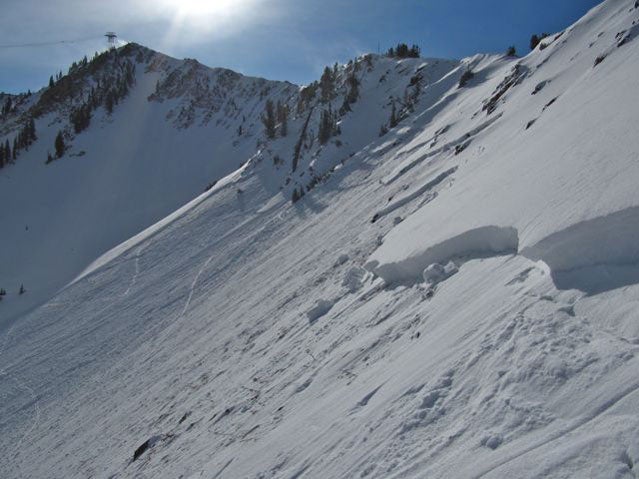Last Sunday, 38-year old pro skier Jamie Pierre died in Utah’s Little Cottonwood Canyon. He was skiing inbounds at , a resort in the Wasatch Range which hasn't opened or begun avalanche control work. While his partner watched, Pierre dropped into a shady, northwest-facing 40-degree slope. The snow immediately cracked through to the ground, releasing an avalanche with a 150-foot-wide crown. It barreled Pierre 800 vertical feet down through a landscape of trees and small cliffs, according to the .
Avalanche Safety
The American Institute for Avalache Research and Education has set up .Gadd Valley
 The crown of the avalanche that killed Jamie Pierre
The crown of the avalanche that killed Jamie PierreFacets
 Facets forming on the surface/cold air interface
Facets forming on the surface/cold air interfaceFacets in detail
 Facets
Facets��
Area avalanche bulletins for the day rated the risk of avalanche activity at considerable to high based on the thin snowpack and base layers of loose, so-called faceted snow and crust. Pierre’s slide started when a slab released on a buried layer of faceted, unstable snow. (When snow first falls, it is usually as classic small, symmetrical snowflakes, but under certain conditions the flakes can grow into weaker, irregularly shaped crystals that don’t bond well.) Many skiers were out touring in the vicinity of Pierre’s accident, and numerous skier-triggered slides were reported.
All the slides ran on the same weak, faceted interfaces near the ground. “Everything at Alta that had a slope angle had a crown,” says Drew Hardesty, a forecaster at the and one of the investigators of the fatal avalanche. ��
The reality that last weekend’s events in the Wasatch made clear is that despite the hype of another La Niña, this season’s snowpack is not shaping up to be the stable, deep powder heaven of the past couple of seasons. Throughout the Intermountain West, states like Montana, Wyoming, and Colorado have seen similar weather patterns as in Utah: early snows followed by cold, clear weather. Observations of the volatility of the weak layers under the snow—such as off Teton Pass, Wyoming—have many avalanche and backcountry experts worried about skiers with early-season powder fever and the effect on the rest of ski season.
Dangerous, weak, and persistent snow layers near the ground form what is called an upside-down snowpack—a loose configuration of crystals that must support the weight of all successive snowfall. , such as the one that caused Pierre’s fatal slide, form when exposed snow is subjected to the extreme temperature gradient between the warmer earth and colder air for periods of time between storms. This creates an unstable base that may remain under the snow for the rest of the season. The weight of more snow, or a skier, can cause these weak layers to fracture—imagine trying to build a brick house on a base of styrofoam peanuts. Varying temperatures early this season have also led to melt-freeze crusts. Snow from subsequent storms won’t be able to form strong bonds with this slick material.
The was the most recent season with an upside-down snowpack. The early-season layers proved to be incredibly unstable. Even in-bounds avalanche control did not reign in it, resulting in three fatalities inside ski resorts. But the extreme volatility kept many out of the backcountry altogether, and the season's 27 fatalities remained near the U.S. average of 25, according the .
In general, the past few seasons in the Intermountain West saw a right side-up snowpack, where continuous snowfall didn’t allow for dangerous layers to form. Successive mid- and late-winter storms piled on top of that sturdier base. This season, forecasters have been observing facets and slick crusts near the bottom layers of this season’s snowpack—which isn’t entirely unusual. Some seasons, these heal up with the right temperatures and storm conditions, says Hardesty. But sometimes they persist, creating widespread instabilities through the winter.
In this kind of upside-down situation, “no matter how good the snowpack builds above it, it is still on a poor foundation,” says Don Sharaf, co-owner of the American Avalanche Institute. “It’s too early to write off the winter season, but it merits caution.”
Around Christmas, forcasters will gain a better understanding of whether the poor basal structure has bonded or it's likely to remain a problem the entire season. Warmer storms, such as rain that turns immediately to snow, can force the weak layers to bond somewhat, and the weight of successive storms can cause avalanches that will take out the problem layers altogether, giving the snowpack a fresh start. “What we need is for it to start storming, or even come in warm to stabilize the facets, and then keep storming,” says the UAC’s Hardesty.
The blissful, right-side-up snowpacks and deep powder that the West enjoyed the past two seasons, especially during the strong La Niña of last season, may have served to allow some skiers to get away with less cautious behavior. Some avalanche experts believe this mentality, in part, led to the dozens of riders rushing out to ski powder in Little Cottonwood Canyon last weekend in spite of the warning signs. “We get habituated to a stable snowpack, and then suddenly, in the same place, with the same people, it is not stable,” says Bruce Tremper, director of the UAC. “We learn our lessons, forget, and learn them again.”
What the snow will end up doing this season—whether it remains as unstable as was seen in Utah last weekend or stabilizes—is not easy to predict.
The easy part, according to CAIC forecaster Tim Brown, is keeping an eye on the conditions that get people into trouble. “Facets or windslabs in a thin snowpack or that persist—that is problematic,” says Brown. “People need to assess what is out there and not make decisions based on what worked last year or in a different snow climate.”
That’s worth saying again, according to the avalanche forecasters interviewed for this story. Aside from watching the snowpack and paying attention to avalanche conditions, people need to make evidence-based decisions on their own. Don’t rely on crowds to estimate the level of dangers. “Humans have a herding instinct—if you see 200 people going in front of you toward familiar terrain, you might think it is safe,” says Tremper.
Individuals venturing into the backcountry should take an and use the skills they learn every time they venture out. Tremper suggests using a checklist to assess avalanche danger, so you can make good decisions without thinking emotionally about powder or what other groups are doing.
“It doesn’t even matter what you think the snowpack is doing,” says Tom Bennett, a Jackson Hole, Wyoming, alpine and heli-ski guide who works in South America and Alaska.�� “If you decide to go out, you can’t let your guard down, and you need to be prepared for the worst.”


